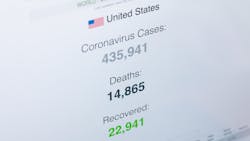Study finds underreporting of US SARS-CoV-2 infections, hospitalizations, and deaths
A study from Pfizer Vaccines author Frederick J. Angulo, DVM, PhD, Medical Development and Scientific/Clinical Affairs reports that the SARS-CoV-2 disease burden may be much larger than reported COVID-19 cases owing to underreporting, according to an article in JAMA Network Open.
Even after adjusting for underreporting, a substantial gap remains between the estimated proportion of the population infected and the proportion infected required to reach herd immunity. Additional seroprevalence surveys are needed to monitor the pandemic, including after the introduction of safe and efficacious vaccines.
Estimates of severe acute respiratory syndrome coronavirus 2 (SARS-CoV-2) infections are needed to understand how interventions can be titrated to reopen society. Seroprevalence data provide an estimate of the proportion of the population who has been infected, and these data can be used for monitoring progress toward herd immunity.
The Centers for Disease Control and Prevention (CDC) indicates that there have been 10,846,373 reported COVID-19 cases and 244,810 deaths in the US through Nov. 15, 2020 with 1,037,962 reported cases within the last seven days of that date (an average of 148,280 reported cases per day). The number of reported cases is an underestimate of the true number of persons with infection because many persons with symptomatic COVID-19 either do not seek medical care or are not tested and therefore are not included in tallies of COVID-19 infections reported to public health authorities. Furthermore, an estimated 40 percent of individuals with SARS-CoV-2 infection are asymptomatic and unlikely to be tested and reported. In this study, data from seroprevalence surveys were used to adjust for underreporting of COVID-19 infections and thereby derive estimates of the number of SARS-CoV-2 infections, symptomatic infections, hospitalizations, and deaths.
In this cross-sectional study using data from public health surveillance of reported COVID-19 cases and seroprevalence surveys, an estimated 46, 910,006 SARS-CoV-2 infections, 28,122,752 symptomatic infections, 956,174 hospitalizations, and 304,915 deaths occurred in the US through Nov. 15, 2020.
Findings of this study suggest that although more than 14 percent of the US population was infected with SARS-CoV-2 by mid-November, a substantial gap remains before herd immunity can be reached.
In this cross-sectional study of respondents of all ages, data from four regional and one nationwide CDC seroprevalence surveys from April to August, were used to estimate infection underreporting multipliers and symptomatic underreporting multipliers.
Community serosurvey data from randomly selected members of the general population were also used to validate the underreporting multipliers. The first four CDC seroprevalence surveys were conducted with specimens from persons in 10 specific states (California, Connecticut, Florida, Louisiana, Minnesota, Missouri, New York, Pennsylvania, Utah, and Washington); the fifth seroprevalence survey was conducted nationwide. For each community serosurvey and for each state participating in the CDC seroprevalence surveys, the seroprevalence estimate was multiplied by the population to estimate the number of infections, and the proportion of reported infections was calculated by dividing the reported cases by the estimated infections.
By mid-November of 2020, a substantial proportion of the US population was infected with SARS-CoV-2. Given that the critical proportion for herd immunity for SARS-CoV-2 (i.e., the proportion of the population that needs to have SARS-CoV-2 antibodies to disrupt ongoing transmission) is approximately 60 percent based on an estimated SARS-CoV-2 reproduction number of 2.5, the US population remains a long way from herd immunity even with millions of new infections each week. The number of estimated COVID-19 deaths is also remarkably more than the reported deaths in the US through Nov. 15, 2020, supporting the conclusion that approximately 35 percent of COVID-19 deaths are not reported.
Reported COVID-19 cases do not represent the full SARS-CoV-2 disease burden. Case reports are dependent on patients seeking healthcare, availability and type of care (e.g., telemedicine), and testing availability. Using data from seroprevalence surveys and surveillance is a common strategy for estimating underreporting and disease burden. This approach was used successfully throughout the 2009 novel influenza A pandemic. For example, in a simple model combining several sources of surveillance data, the CDC estimated 55 million symptomatic infections of 2009 pandemic influenza A (pH1N1) had occurred in the US by December 2009. This finding was consistent with an estimate from a seroprevalence survey for same period estimating 59 million infections (including asymptomatic infections).
JAMA Network Open has the article.